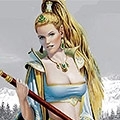Experience Points: EQN Features Reviewed (Part 1)
EverQuest Next is bringing a lot of changes, but will they live up to the hype?

Each week, Chris "Syeric" Coke gives his unfiltered thoughts on the MMO industry. Taking on the news and hottest topics, Chris brings his extensive experience as a player and blogger to bear in Experience Points. This week he breaks down the upcoming features of EverQuest Next and asks if they're all they're chalked up to be.
Sony rocked the MMO world last Friday. With the announcement of the much anticipated EverQuest Next, David Georgeson and his design team laid their cards on the table: this is the future of MMOs, not “the same game” everyone else is making, and we hope it's the game for you. There are a lot of interesting ideas being offered and some of them could even be revolutionary. Others, well... let's just say that the hype machine is in full motion. We did our best to cover it here and bring you the news as it broke. Over the next two columns, I'd like to look at each of the big features, from destructibility to Landmark, and separate the amazing from the overblown. Join me and share your thoughts in the comments below.
Enhanced and Stylized Graphics

EverQuest Next is a departure for the franchise. Both EverQuest and EverQuest II aimed toward realism and, sadly, rendered each game ugly over the long-term. Next is taking a stylized, exaggerated approach to its artistry, one much closer to that of World of Warcraft than fans might have been expecting. What we've seen of the world is reminiscent of the films of Pixar, especially in the funny, overly-emotive character models. What stands out most to me is the game world. Everything feels mysterious and magical but also non-threatening; it feels like a place to be explored rather than hidden from.
This is all a stroke of genius. One need look no further than EverQuest II to see what a folly realistic graphics are. Put simply: they age. In time, they drive players away rather than lure them in. I want to play a game with vision, and one with a sense of identity that isn't a shallow mimicry of real life. Stylized graphics free players from the Uncanny Valley and allow them to accept the world as an imaginative artwork. Once the heavy lifting of acceptance is done, the silky set-in of immersion can begin.
Heroic Movement

Movement is one of the features that MMO players take for granted. How complicated is it to make a character model move, after all. Do we really need innovation? Then a game comes along that actually innovates on these ideas and we get major game sites writing articles about it. Movement is a given but that doesn't mean we should settle for the status quo.
EverQuest Next is taking that idea to heart with its Heroic Movement System. When your character comes across a low obstacle, he'll vault over it. When there is a steep hill, he'll slide down. If you encounter a small gorge, you can double jump, blink, or power leap to the other side. Items, such as speed boots, can be donned which let you give your best impression of a gazelle.
All of this is neat but overblown. Heroic Movement is a solid addition to the genre, but it's also one we'll stop noticing in mere days. That is the nature of movement after all, it should disappear: if it feels natural, it stops standing out and starts blending in. In other words, it's good that Sony is talking about it, but something that is forgettable by design won't be what sells me the game.
Action Combat and Limited Abilities

Since Guild Wars 2, there has been a trend away from action bars. Sony, like ArenaNet, doesn't want you focusing on the user interface while you play. Instead, they want you in the heat of the battle. You will have limited abilities stemming from your class and your weapon (also from Guild Wars 2), and they'll chain together naturally to create visceral, heavy-impact combat which literally leaves craters in the ground.
I am of two minds on this. Action combat is the direction of the industry. It is the middle ground between the console action experience and the MMO kill quest, and an all important factor should EQN make its way to the Playstation 4. It is also the utter degradation of player friendships. When you're dodge rolling, you're not talking. That said, there's no sense being a curmudgeon about it. Action combat can be a blast and the feeling of making contact against an enemy (or group of enemies) is hard to argue with.
What I'm not a fan of is the limited abilities. With only eight total at any given time (four from the class (offense, defense, movement, and utility) and four from the weapon, I'm let down. And I'm sorry, but Guild Wars 2 didn't do this industry any favors with weapon-based “let's remove the fun part of leveling” ability system. Thankfully, EverQuest Next is only adopting part of that and giving players class skills and weapon skills. It will be interesting to see how things develop, but I'm tired of the cattle-call that fewer abilities is better. Isn't one of the core criticisms against RIFTthat the macro system leads to too few abilities to use? There is no having your cake and eating it too. More abilities is a good thing so long as each one has a use. It's time to move on from the over-simplification.
That EQN allows you to mix and match from each class, and switch weapons, is a boon but I'm still skeptical that it will be any better, if not a little more restrictive, than traditional MMOs.
No Levels and Multi-classing

Conceptually, I love the idea of a game without levels; one where you can hop in and start accomplishing things right off the bat. Practically though, it's a non-starter. There has to be an element of progression. Players need to climb that hill meet other players at the top. They need to experience the repeated dings of the upward climb. If everyone can do everything (“the endgame starts at level one!”), your game isn't much of an RPG. It's a problem.
Next's answer is to base progression around collecting new classes and exploring the world. I am in love with this idea. Purposeful exploration is something that has been sorely lacking in this industry. We explore to strike off a checklist. We explore to complete quests. In EQN, we'll explore to find those quests, gain new abilities, and to discover all that the game has to offer. What we know so far says that there are no markers over quest giver's heads. We'll have to talk to them and find out. If they don't have a quest, maybe they'll have something else of value like a little nugget of lore to draw us further into life in Norrath.
Centering progression on the multi-classing system is incredibly smart. One of the key problems facing level-less games is that they often lack the repeated reinforcement that levels provide. It feels good to fill that experience bar and earn a boost in stats with a golden flourish. It feels even better to unlock a powerful new ability. Next's reply is to replace those flourishes with whole sets of abilities that can be mixed and matched into something completely new. There is also some vertical progression within the tiers of each class. The system is so open, however, that classes might simply be more of a marketing term than a description of a system as we know it.
Too Many Words, Too Little Time
That's all we have time for this week, but there is so much more to talk about. For example, I am dying to talk about EverQuest Next's holy trinity-lite system, where tanks tank and feel important but aren't required to tank to feel important. Make sense? Me either, and as a tank, I'm worried. Or that players can explode holes into Norrath's surface and uncover entire new zones. There may be more there than meets the eye. What really excites me, though, is the emergent AI system. I know one of the developers behind it and couldn't really be more hyped. All this and more in next week's follow up, EQN Features Reviewed (Part 2).
Chris “Syeric” Coke
Follow him on Twitter: @GameByNight


